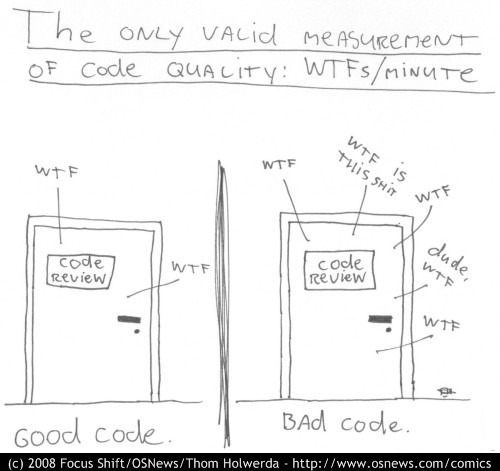The rss feed for this site has been changed to http://feeds.feedburner.com/howwework.
Please update your rss clients.
Friday, May 02, 2008
Tuesday, April 08, 2008
Automation for the people: Continuous Integration anti-patterns
 Image by Phillie Casablanca via FlickrAutomation for the people: Continuous Integration anti-patterns discusses some interesting no-no's in software development team practice.
Image by Phillie Casablanca via FlickrAutomation for the people: Continuous Integration anti-patterns discusses some interesting no-no's in software development team practice.Today I ran into one, namely 'infrequent check-ins' but it was hidden under a pile of branching/merging confusion.
I was discussing branching and merging strategies for the development teams with one of the team members. He explained how work was done for some time, apparently to his satisfaction. A project team would branch off a release branch at the point when a release was going in acceptance test. The team would work on that, fixing issues, and would never merge back into the trunk, except for some cherry-picked bugs.
So far, I don't object to this way of working, but I introduced the idea of personal branches, or an alternative, feature branches, where developers would create branches for every feature, work on that and then merge it back into the stream of the release where that feature belonged in. Wholesale merges, in other words.
This was out of the question. Merges were supposed to be controlled, high exception operations performed under high levels of scrutiny.
This encourages infrequent check-ins: it prevents developers from doing frequent check-ins while working on their own corner of the project. A developer shouldn't only check in when they want to add a major feature; Ideally one should check in after every few lines of code which prove ok. However if one pollutes the main source tree with every little commit, then, yes, this is impractical.
The solution however is not to delay or generally discourage merges. One should setup branching policy so that developers can check-in however often they want without bothering the main line.
Conclusion
Sometimes it takes some time to discover a bad practice in disguise. The no-no of 'Infrequent Checkins', and all the other anti-patterns too, can be disguised in many ways of 'practice' which seems perfectly reasonable by itself. Until you fully work through the consequences.
Btw, don't forget to read part 2 of the anti-patterns article.
Thursday, March 27, 2008
The Selfish Class
The Selfish Class
Another gem from the author(s) of 'The Big Ball Of Mud' (see links in the sidebar).
The basic question of the essay is what would a class need to have/do in order to promote its own re-use.
Another gem from the author(s) of 'The Big Ball Of Mud' (see links in the sidebar).
The basic question of the essay is what would a class need to have/do in order to promote its own re-use.
Thursday, February 28, 2008
The Years of Experience Myth
Coding Horror has an article on how to find good programmers, and how not to: The Years of Experience Myth
 Image via WikipediaActually, when I went through my latest job hunting exercise (which ended quite happily), I had a recruiter who started out with counting the 'years of experience' per programming language that I had. Since I have been collecting them all (not really, but I like to diversify), I had at most 2 to 3 years max in each of them. This would make me slightly above junior level in any of those languages at most.
Image via WikipediaActually, when I went through my latest job hunting exercise (which ended quite happily), I had a recruiter who started out with counting the 'years of experience' per programming language that I had. Since I have been collecting them all (not really, but I like to diversify), I had at most 2 to 3 years max in each of them. This would make me slightly above junior level in any of those languages at most.
After a few discussions, I managed to convince him of two things: First, your missing the bigger picture of my capabilities this way, and second, programmers do not like to be recruited this way. It tells much more about the (lack of) capabilities of the recruiter than of the candidate.
Lucky for me (and him I suppose), the recruiter came around quickly, and found a great job for me. I forwarded the above article to him afterwards, since it so aptly confirms the point I was trying to make at the time.
 Image via WikipediaActually, when I went through my latest job hunting exercise (which ended quite happily), I had a recruiter who started out with counting the 'years of experience' per programming language that I had. Since I have been collecting them all (not really, but I like to diversify), I had at most 2 to 3 years max in each of them. This would make me slightly above junior level in any of those languages at most.
Image via WikipediaActually, when I went through my latest job hunting exercise (which ended quite happily), I had a recruiter who started out with counting the 'years of experience' per programming language that I had. Since I have been collecting them all (not really, but I like to diversify), I had at most 2 to 3 years max in each of them. This would make me slightly above junior level in any of those languages at most.After a few discussions, I managed to convince him of two things: First, your missing the bigger picture of my capabilities this way, and second, programmers do not like to be recruited this way. It tells much more about the (lack of) capabilities of the recruiter than of the candidate.
Lucky for me (and him I suppose), the recruiter came around quickly, and found a great job for me. I forwarded the above article to him afterwards, since it so aptly confirms the point I was trying to make at the time.
Sunday, February 24, 2008
How not to design space shuttles. Or software.
Gustavo Duarte provides us with Richard Feynman, the Challenger Disaster, and Software Engineering, showing parallels between Space Shuttle engineering and software engineering. Very lucid, as to be expected of Mr. Feynman.
Tuesday, February 19, 2008
Tuesday, January 29, 2008
See kids? Modularity *is* good!

Here's a good one: we show that tightly coupled components have a higher probability of survival as a design evolves; in essence, they are “harder-to-kill.” We also find that tightly-coupled components are harder to maintain, in that they are more likely to experience surprise design changes unrelated to newly added or removed functionality. Finally, we show that tightly-coupled components are harder to augment, in that the mix of new components added in each version is significantly more modular than the legacy design. These results have important implications for managers, highlighting the impact of design decisions made today on both the evolution and maintainability of a design in subsequent years.
Basically they say that you don't want to mess around with objects that are hard to kill. I tend to agree.
Ok, now that I've actually read the article, it occurred to me that the central, hard to kill objects in most applications are the data objects. These are the payloads of data you pass around as arguments between your methods.
The key concepts of your business are represented by data objects, ie. customer, account, order, product etc. These objects are used by many of your processes, so data objects have a high visibility (good for survival, not good for adaptibility). Thinking long and hard about the definition of your data is thus a money saving tactic.
 Image via WikipediaOk, maybe I go a little fast here. The href'd article also shows that in later releases, much of the maintenance effort (read: cost) is sinking into the legacy, hard to kill, hard to maintain, objects. I propose that data objects are a fair share of that. This implies that designing your data objects well can cut on maintenance costs later on in the project.
Image via WikipediaOk, maybe I go a little fast here. The href'd article also shows that in later releases, much of the maintenance effort (read: cost) is sinking into the legacy, hard to kill, hard to maintain, objects. I propose that data objects are a fair share of that. This implies that designing your data objects well can cut on maintenance costs later on in the project.The actual technology that produces the data objects isn't under discussion here. I don't care if my CustomerObject comes out as a POJO, entity bean, or as a chunk of xml. The actual data and definition of a customer, that's what I need to know.
In this regard, the REST architecture fits nicely. Within this architecture, most of the design effort is concentrated on the data formats, or resource definition. In contrast, the operations on that data are simple, as in equivalent with HTTP commands (GET POST PUT etc). This way the design effort must be spent at defining meaningful resources and formats.
Another thing comes to mind. The XML folks have over time gained some experience in how to handle evolving specs for their formats. This knowledge is perfectly suitable to 'evolve' entity data objects into more modular forms , so that they do not become legacy (see again the pdf for how that's bad).
Maybe it's worthwhile to think about refactoring data, or designing data for modularity and adaptability?
Thursday, January 10, 2008
How to Sneak Social Media into the Enterprise
How to Sneak Social Media into the Enterprise
The issues organizations usually have with this style of working stem from the rise of networked individualism. This networked individualism is now just developing, but it exists within the current group- and locality-based organization of society (ie. enterprises). Where the links in the networked individual's network cross a group boundary, problems will arise (from the groups perspective) and counter-measures are taken to ensure group-think, thus crippling the networked individual's productivity.
In a group-based society you belong to many groups at once, but in some circumstances (such as when you're at work), you are to behave as if you are in one group only. I think that over time, the group strategy will become less attractive, as knowledge-workers of the networked-individual style will prove to be more productive than their inward looking, group-focused colleagues. The author of the linked article certainly proves my point.
My own belief is that linking to resources (including people) is much more efficient than copying and storing information. The corporate information network is already there and it's called the internet. Lots of expert systems are already at your disposal, they walk on two legs and may or may not work for the same company. In an always-on, high-bandwidth environment, it is probably more efficient to just ask your trusted expert-friends than to gather and hoard knowledge in a corporate cathedral.
Wednesday, January 09, 2008
Performance Appraisals considered harmful

Abolishing Performance Appraisals makes a powerful case for removing this well intended yet ineffective ritual organizations have been requiring for decades. Coens and Jenkins provide solid reason why appraisals have to go, to be replaced with quality feedback mechanisms including coaching and support structures that enable employees to maximize their own potential.(synopsis by reviewer Carlos Quintero.)
Although there is no 'cookbook' approach for designing an organization that does not need appraisals, in my opinion being democratic is a good start.
Btw, I'm reading the Dutch version.
Tuesday, January 08, 2008
Traci Fenton, WorldBlu CEO, on organizational democracy
Traci Fenton on organizational democracy. The concept of organizational democracy as explained here comes very close to my own opinions about organization.
This brings to my mind Free speech versus bureaucracy, a chapter from Information liberation, challenging the corruptions of information power, by Brian Martin.
This brings to my mind Free speech versus bureaucracy, a chapter from Information liberation, challenging the corruptions of information power, by Brian Martin.
Friday, January 04, 2008
Telecommuting has mostly positive consequences for employees and employers, say researchers
Flexible work arrangements give workers more control over their environment, which helps performance and overall job satisfaction.
Apparently that also benefits the company, as the results also contained "...that telecommuters reported more job satisfaction, less motivation to leave the company, less stress, improved work-family balance, and higher performance ratings by supervisors."
I've always wondered why the take-up of telecommuting arrangements has been so slow. One would expect it to at least alleviate the daily rush-hour traffic. Somehow the irony of going into office everyday (I work for an internet provider) escapes most people.
Apparently that also benefits the company, as the results also contained "...that telecommuters reported more job satisfaction, less motivation to leave the company, less stress, improved work-family balance, and higher performance ratings by supervisors."
I've always wondered why the take-up of telecommuting arrangements has been so slow. One would expect it to at least alleviate the daily rush-hour traffic. Somehow the irony of going into office everyday (I work for an internet provider) escapes most people.
Subscribe to:
Posts (Atom)
Unless otherwise expressly stated, all original material of whatever nature created by razor_nl and included in the 'How We Work' weblog and any related pages, including the weblog's archives, is licensed under a Creative Commons License.

